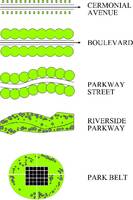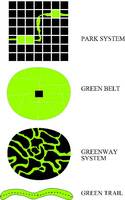- England
- Scotland
- France
- Holland
- Germany
- Italy
- Spain
- Portugal
- USA
- China
- Japan
- India
- Iran
- Advice
- Gardens
- England
- Scotland
- France
- Holland
- Germany
- Italy
- Spain
- Portugal
- USA
- China
- Japan
- India
- Iran
- Advice
- Garden Tours
Book: Landscape Planning and Environmental Impact Design: from EIA to EID
Chapter: Chapter 4 Public open space POS
They should be 'green' in the environmental sense and 'ways' in many senses. The best official account of the greenway idea comes from the President's Commission on Americans Outdoors. It called for: A Living Network of Greenways... to provide people with access to open spaces close to where they live, and to link together the rural and urban spaces in the American landscape ... threading through cities and countrysides like a great circulating system (President's Commission on Americans Outdoors 1987). Charles Little's 1990 book Greenways for America gave further impetus to the idea and greenways are now being made in many countries. Little says the five greenway types are: urban riverside, recreational, ecological, scenic and historic, comprehensive (Little 1990). In an introduction to a major review of greenways, in 1995, Fabos sees the greenway movement as being in its infancy and suggests that at some future point greenway systems 'will be as evident on national, state, regional and local maps as our highway or railway networks are today' (Fabos 1995). I look forward to that day. Ahern offers an inclusive definition of greenways: Greenways are networks of land containing linear elements that are planned, designed and managed for multiple purposes including ecological, recreational, cultural, aesthetic or other purposes compatible with the concept of sustainable land use (Ahern 1995). I would prefer to define a greenway as "a route which is good from an environmental point of view". This definition uses 'green' as an environmental term and 'way' in a broad sense to include circulation routes for people, animals, air, water and plants. The actual term 'greenway' was formed by joining greenbelt to parkway. It embraces a wide range of concepts drawn from the history of linked open space [Fig 4.20]. 4.20 The greenway concept has a history of at least 3,000 years. The greenway concept may be said to have come of age with the publication of a special issue of Landscape and Urban Planning in 1995 (Ahern & Fabos 1995), reprinted as a special book (Ahern & Fabos 1996). Greenways can be planned to serve distinct functions, which are likely to overlap [Fig 4.21]. 4.21 Greenways can be planned to serve distinct functions, which are likely to overlap


